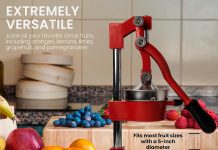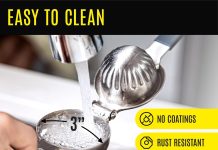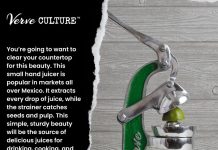Have you ever wondered how much juice you can actually get from your favorite fruits and vegetables? It’s a question we’ve all pondered while standing in front of our juicers, hoping to squeeze out every drop of liquid goodness. In this article, we will explore the different factors that can affect the juice yield, from the type of produce to the juicing method used. Get ready to quench your thirst for knowledge as we uncover the secrets behind extracting the maximum amount of juice from your favorite fruits and vegetables.
Review contents
Factors Affecting Juice Extraction
Juicing is a popular way to enjoy the natural goodness and flavors of fruits and vegetables. However, the amount of juice you can extract from different types of produce can vary due to various factors. In this article, we will explore the factors that affect juice extraction and provide you with tips on maximizing your juice yield.
Ripeness and Quality of Fruit/Vegetables
The ripeness and quality of the fruit or vegetable you choose to juice can have a significant impact on the amount of juice you can extract.
Effect of Ripeness on Juice Yield
When it comes to juice extraction, riper fruits tend to yield more juice compared to unripe ones. This is because as fruits ripen, their cell walls break down, making it easier for juice to be released. Fully ripened fruits are also generally sweeter, resulting in a more flavorful juice.
Effect of Fruit/Vegetable Quality on Juice Yield
The quality of the fruit or vegetable you use for juicing also plays a role in juice extraction. Choosing fresh, high-quality produce ensures that you get the most juice out of your fruits and vegetables. Damaged or overripe produce may not yield as much juice, as they can have decreased water content and compromised cell integrity.
Type of Juicer Used
The type of juicer you use can greatly influence the amount of juice you can extract from your fruits and vegetables. There are several types of juicers available, each with its own pros and cons.
Centrifugal Juicers
Centrifugal juicers are a popular choice among juicing enthusiasts due to their efficiency and speed. These juicers work by spinning a blade at high speeds to extract juice from the produce. They are particularly effective for juicing firm fruits and vegetables, such as apples and carrots. However, centrifugal juicers may not be as efficient in extracting juice from leafy greens or soft fruits.
Masticating Juicers
Masticating juicers, also known as cold press or slow juicers, operate at a slower speed, which helps preserve more of the nutrients in the juice. These juicers use a chewing or grinding motion to extract juice from the produce. Masticating juicers are highly versatile and can extract juice from a wide range of fruits and vegetables, including leafy greens and soft fruits. They are particularly effective for maximizing juice yield, as they leave behind dry pulp.
Citrus Juicers
Citrus juicers are specifically designed for juicing citrus fruits such as oranges, lemons, and grapefruits. These juicers are equipped with a cone-shaped reamer that extracts the juice when the fruit is pressed onto it. Citrus juicers are highly efficient in extracting juice from citrus fruits, as they are designed to separate the pulp and seeds from the juice.
Preparation of Fruit/Vegetables
The way you prepare your fruits and vegetables before juicing can also affect the amount of juice you can extract.
Washing and Peeling
Thoroughly washing your fruits and vegetables is essential to remove any dirt, pesticides, or other contaminants. However, peeling is not always necessary, as many fruits and vegetables contain valuable nutrients in their skins. If you choose to peel your produce, keep in mind that some fruits, such as apples and pears, have a significant portion of their nutrients in the skin, so consider leaving it on.
Cutting and Slicing
Cutting or slicing your fruits and vegetables into smaller pieces can make juicing more manageable and efficient. By reducing the size of the produce, you can help the juicer extract juice more effectively. For example, for leafy greens, tearing them into smaller pieces can prevent them from wrapping around the juicer’s blade.
Removal of Seeds/Pits
Certain fruits, such as grapes and citrus fruits, may contain seeds or pits that can affect the taste and texture of the juice. Removing these seeds or pits before juicing can help ensure a smoother juice with a more pleasant flavor.
Efficiency of Juicing Process
The efficiency of the juicing process itself can impact the amount of juice you can extract. Consider the following factors when choosing a juicer:
Pulp Ejection System
A juicer with a pulp ejection system allows for continuous juicing without the need to stop and empty the pulp container frequently. This can save you time and make the juicing process more efficient, especially when preparing large batches of juice.
Adjustable Pulp Control
Some juicers offer adjustable pulp control, allowing you to customize the pulpiness of your juice. If you prefer juicing with more or less pulp, look for a juicer with this feature to ensure your juice is to your liking.
Speed Settings
Different types of produce require different juicing speeds for optimal results. Juicers with multiple speed settings give you the flexibility to adjust the speed based on the type of fruit or vegetable you are juicing. Lower speeds are typically recommended for leafy greens and soft fruits, while higher speeds work well for firm fruits and vegetables.
Common Fruits
Let’s explore the juice extraction potential of some common fruits:
Oranges
Oranges, known for their vibrant color and refreshing taste, are an excellent source of vitamin C and other essential nutrients. Depending on their size and juiciness, oranges can yield a moderate to high amount of juice.
Apples
Apples are a popular choice for juicing due to their natural sweetness and versatility. They can be juiced on their own or mixed with other fruits and vegetables. Apples generally yield a moderate amount of juice, and the juiciness can vary depending on the variety.
Grapes
Grapes, whether red, green, or purple, are packed with antioxidants and known for their deliciously sweet juice. However, extracting juice from grapes can be a bit challenging due to their small size and high water content. Despite this, grapes can still yield a moderate amount of juice.
Pineapples
The tropical flavor of pineapples adds a delightful twist to any juice. Pineapples have a high water content, making them quite juicy and perfect for juicing. They yield a moderate to high amount of juice, depending on their size and ripeness.
Berries
Berries, such as strawberries, blueberries, and raspberries, are bursting with flavor and loaded with antioxidants. However, due to their small size and high fiber content, extracting juice solely from berries can be challenging. It is often more effective to blend berries with other fruits or use a masticating juicer for better juice yield.
Common Vegetables
Now, let’s explore the juice extraction potential of some common vegetables:
Carrots
Carrots are a popular vegetable choice for juicing due to their vibrant color and natural sweetness. They are also packed with vitamins and minerals. Carrots yield a high amount of juice, and their firm texture makes them compatible with both centrifugal and masticating juicers.
Kale
Kale has gained popularity as a nutrient-rich superfood, and juicing is a great way to incorporate this leafy green into your diet. While kale has a high nutritional value, it does not yield a substantial amount of juice on its own due to its fibrous nature. Combining kale with other juicier fruits and vegetables or using a masticating juicer can enhance the juice yield.
Spinach
Spinach is another leafy green that offers numerous health benefits. Although spinach is not known for its juiciness, it can still yield a moderate amount of juice, especially when paired with juicier produce like apples or cucumbers.
Celery
Celery is a hydrating vegetable that is often used as a base in many juice recipes. Despite its high water content, celery does not yield a significant amount of juice on its own. However, its mild flavor and crunchy texture complement other fruits and vegetables in juice blends.
Beets
Beets are known for their earthy flavor and vibrant color. They are packed with nutrients, including antioxidants and dietary fiber. Beets yield a moderate to high amount of juice, depending on their size, making them a great addition to your juicing repertoire.
Juice Yield Comparison
Different fruits and vegetables vary in their juice extraction potential. Here’s a comparison of high-yield and low-yield options:
High-Yield Fruits
Some fruits that generally yield a high amount of juice include oranges, pineapples, and apples. These fruits tend to have high water content and are often juicy, making them ideal for juicing.
Low-Yield Fruits
On the other hand, certain fruits like berries, particularly raspberries and strawberries, yield a relatively low amount of juice due to their small size and high fiber content. Mangoes and peaches are also considered low-yield fruits, as their flesh can be fibrous and less juicy.
High-Yield Vegetables
Vegetables that are known for their high juice yield include carrots, cucumbers, and celery. Their high water content and firm texture make them excellent choices for maximizing juice extraction.
Low-Yield Vegetables
Leafy greens, such as spinach and kale, are considered low-yield vegetables when it comes to juice extraction. While they may not yield a significant amount of juice on their own, combining them with juicier fruits and vegetables or using a masticating juicer can help increase the juice yield.
Tips to Maximize Juice Extraction
To ensure you get the most out of your juicing experience, here are some tips to maximize juice extraction:
Use Ripe and High-Quality Produce
Choose ripe fruits and vegetables that are of high quality. Ripe produce is typically juicier and easier to extract juice from, resulting in a higher juice yield. Additionally, high-quality produce ensures that you maximize the nutritional value of your juice.
Choose the Right Type of Juicer
Consider the type of produce you plan to juice and select a juicer that is most suitable for that purpose. Centrifugal juicers work well for firm fruits and vegetables, while masticating juicers are better for leafy greens and soft fruits. Citrus juicers, as the name suggests, are ideal for extracting juice from citrus fruits.
Optimal Fruit/Vegetable Preparation
Properly wash your produce to remove any dirt or contaminants, and consider leaving the skins on for fruits and vegetables that contain valuable nutrients in their skins. Cut or slice your produce into smaller, manageable pieces to facilitate the juicing process. Removing any seeds or pits beforehand can also help ensure a smoother juice.
Consider Juicer Efficiency and Features
Look for juicers with efficient pulp ejection systems and adjustable pulp control to streamline the juicing process and customize your juice to your preference. Juicers with multiple speed settings allow you to adjust the juicing speed based on the type of produce, ensuring optimal juice extraction.
Conclusion
The amount of juice you can extract from fruits and vegetables depends on various factors, including ripeness, quality, juicer type, preparation, and juicing efficiency. By selecting ripe and high-quality produce, choosing the right type of juicer, properly preparing your fruits and vegetables, and considering the features of your juicer, you can maximize your juice yield and enjoy the full benefits and flavors of freshly extracted juice. So, grab your favorite fruits and vegetables, fire up your juicer, and start enjoying the delicious and nutritious benefits of juicing!


































